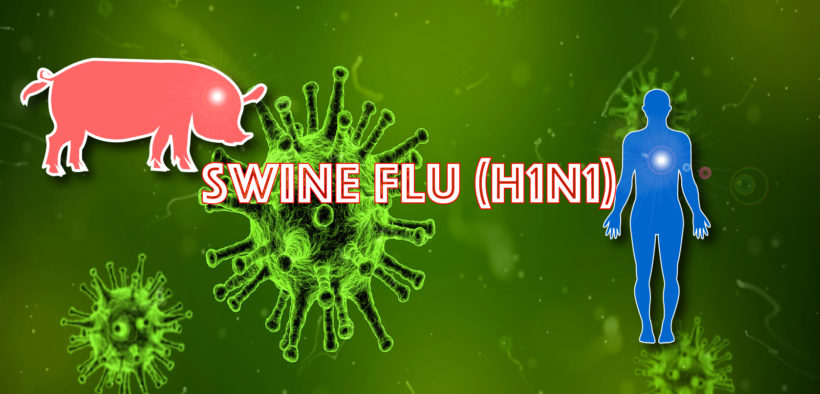कैसे करें स्वाईन फ़्लू से बचाव

भारत में पूरे साल ही स्वाईन फ़्लू के मामले सामने आते रहते हैं। हर साल बहुत से लोग मौसम के साथ होने वाले इंफ्लूएंज़ा विषाणु(H1N1) के शिकार होते हैं। ये तीन श्रेणियों,ए,बी और सी में पाया जाने वाला सबसे संक्रामक और सबसे ज़्यादा फैलने वाला वायरस है। ए और बी श्रेणी में घर पर देखभाल की ज़रूरत होती है जबकि सी श्रेणी के वायरस में तुरंत अस्पताल में भर्ती होने और चिकित्सा की ज़रूरत होती है क्योंकि इसके बढ़ने पर इस से मौत भी हो सकती है।
Fortis Flt. Lt. Rajan Dhall अस्पताल के आंतरिक चिकित्सा विभाग के निदेशक डॉ. डी.एस.चढ्ढा कहते हैं कि H1N1 फ़्लू ठीक हो सकता है। बुख़ार, खाँसी, ख़राब गला, सरदर्द और बेचैनी, उल्टी और दस्त होना इसके लक्षण हैं। बच्चों, बुज़ुर्गों, गर्भवती महिलाओं और फेफड़ों के पुराने रोगियों को ये फ़्लू ज़्यादा होता है।
स्वाईन फ़्लू (H1N1) की शुरुआत:
H1N1 वायरस सबसे पहले सुअर में पाया गया था। अब ये वायरस मनुष्य की जान भी ले सकता है। शुरुआत में इस की वजह से तेज़ खाँसी और छींकें आती हैं। राष्ट्रीय रोग नियंत्रण केन्द्र के अनुसार 25 मार्च 2019 तक भारत में H1N1की वजह से 741 लोगों की मृत्यु होने और कुल 21982 मामले सामने आने की पुष्टि हुई थी। इसी समय में दिल्ली में 21 मरीज़ों की मृत्यु हुई थी और 3512 मामले सामने आए थे।
स्वाईन फ़्लू (H1N1) का इलाज:
ऐसे मामले बढ़ने पर चिकित्सकों को सलाह दी गई है कि इंफ्लूएंज़ा का शक़ होते ही मरीज़ों का जल्दी से एंटीवायरल दवाओं से इलाज किया जाए।
हार्ट केयर फ़ाउंडेशन ऑफ़ इण्डिया के अध्यक्ष डॉ. के.के. अग्रवाल कहते हैं कि डॉक्टर की निगरानी में इलाज के लिए टामिफ़्लू(oseltamivir phosphate) दिया जाना चाहिए। एक बार इंफ्लूएंज़ा का पता चलने पर पाँच साल से कम उम्र के बच्चों, गर्भवति महिलाओं और पुरानी बीमारी के रोगियों का तुरंत इलाज किया जाना चाहिए।
(H1N1) स्वाईन फ़्लू के लक्षण:
तेज़ बुख़ार, सूखी खाँसी, नाक बहना, थकान और सरदर्द। कुछ मरीज़ों में गले की ख़राश, शरीर पर चकत्ते या रैश होना, शरीर में दर्द, सरदर्द, सर्दी, चक्कर आना, उबकाई, उल्टी और दस्त होना लक्षण भी पाए जाते हैं।
किसे स्वाईन फ़्लू होने की सबसे ज़्यादा आशंका है?
- पाँच साल से कम उम्र के बच्चे को
- 65 साल के अधिक उम्र के बुज़ुर्ग को
- दमा, दिल, गुर्दे, लीवर और तंत्रिका आदि संबंधी पुराने रोगियों को।
- HIV के मरीज़ों को
- गर्भवती महिलाओं को
- मोटापे का शिकार व्यस्कों को
- पुराने रोगों के चिकित्सा केन्द्रों और नर्सिंग होम में रहने वालों को
(H1N1)ए और बी इंफ़्लूएंज़ा के घरेलू देखभाल के टिप्स:
- डॉक्टर से सलाह लें कि मरीज़ को एंटीवायरल दवाओं की ज़रूरत है या नहीं
- मरीज़ घर के अंदर ही रहे और स्कूल या कार्यालय ना जाए
- मरीज़ आराम करे और शरीर को पानी की कमी से बचाने के लिए ख़ूब तरल पदार्थ ले
- खाँसते और छींकते समय रुमाल ज़रूर लें और साफ़-सफ़ाई का पूरा ध्यान रखें
- वायरस को फैलने से रोकने के लिए हर समय चेहरे पर मास्क ज़रूर पहनें

















